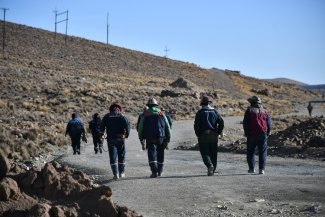Béatrice Boulanger cried when she learned that she would have to stop work as a home helper: “I was fond of my grannies and grandpas.” She has a shoulder replacement, shoulder joint cartilage deterioration, narrowing of the cervical spine and osteoarthritis of the neck and thumb. “The surgeon told me all my health problems come from heavy lifting.” He also said that at 52 she had the body of a much older woman.
After 10 years making trousers in a factory, Boulanger became a home helper visiting elderly people, some seriously ill, several times a day. “There was no training, so I learned everything on the job. I worked with a lot of overweight people and that’s when I ruined my shoulder.” In February 2015, when she was helping an old lady out of the bath, her shoulder gave way. “Everything around the joint was crumbling. The doctors had to cut off the head of my humerus.”
More and more women like Boulanger are having work-related accidents. According to France’s Anact (National Agency for the Improvement of Working Conditions), “accidents requiring time off work fell by 15.3 per cent overall between 2001 and 2015, but rose for women.” The report continues: “[The time off] fell by 28.6 per cent for men but rose by 28 per cent for women.” This is partly explained by the changing nature of employment in France: industrial jobs traditionally done by men are vanishing, while large numbers of women have entered the labour market in sectors where health and safety issues are not officially recognised.
The history of occupational health also helps to explain the problem. The concept of hardship (developed in industries such as construction, chemicals and metalworking) was initially defined using masculine criteria.
France’s CESE (Economic Social and Environmental Council) noted in 2010: “There has been virtually no research from a gender perspective. The impact of occupational risk factors on women’s health remains in many ways invisible. They are unfamiliar, underestimated and consequently not properly taken into account.”
The C3P (Personal Work Hardship Prevention Account) introduced in 2015 listed 10 hardship factors, including work under hyperbaric, hot or noisy conditions and night work, for which workers were given points according to their degree of exposure. These points allowed workers to finance a transition to part-time work, take early retirement or retrain for other occupations.
Four criteria – handling heavy loads, uncomfortable working positions, mechanical vibrations and chemical risks – have since been abolished by the government of President Emmanuel Macron as part of its reform of France’s labour laws, and the C3P has become an Occupational Prevention Account (C2P).
But the problem is unchanged. Today, as in 2015, only one of the criteria applies to more women than men: repetitive work, done by 9.2 per cent of female employees compared with 7.6 per cent of male. For the other criteria, the minimum threshold is often too high for women to have their hardships recognised.
Invisible occupational diseases
Supermarket checkout operators scan around a tonne of goods every hour, but according to the 2015 criteria they don’t reach the minimum threshold for handling heavy loads — lifting or carrying 15kg for at least 600 hours in a year. The high rate of part-time work in this occupation and the way hardship is calculated (weight per single load, rather than cumulative weight) kept them under the radar.
Checkout operators are also invisible in terms of occupational diseases. According to psychoanalyst Marie Pezé, “most suffer from strain of the brachial plexus, a network of nerves reaching deep in the body [between the neck and armpit]. This is not listed in Table 57 of occupational diseases.” The history of this belated and incomplete table, drawn up in 1972, shows the obstacles to recognising the hardships in work done by women. It lists musculoskeletal disorders (MSDs), problems caused by low-intensity repetitive work, to which women are often exposed.
These occupational diseases were observed among bakers, weavers and copyists in the early 18th century by an Italian professor of medicine, Bernardino Ramazzini. In the 19th century they were also noted in laundrywomen and seamstresses. In 1955 some diseases qualified for compensation for the first time: those resulting from the use of pneumatic hammers and other vibrating tools (in jobs traditionally done by men).
Though occupational physicians and the Macron government have identified new risk occupations (miners, typists, assembly line workers, slaughterhouse or cannery workers), “the mobility of many workers assigned to repetitive work, especially women and immigrants, tends to obscure problems,” writes Nicolas Hatzfeld of the University of Evry. It took nearly 20 years for MSDs to be fully recognised, starting with water on the knee affecting civil engineering and construction workers, followed by tendonitis and nerve compression, common in women’s occupations.
Rachel Saada, an expert on labour law, stresses the ambiguities of this recognition for both men and women: “The term ‘hardship’ has clouded the issue. It is used to trivialise suffering and pretend that action is being taken to eliminate the harm caused by poor work organisation.”
Sociologist Pascal Marichalar says: “Imagine replacing the word ‘hardship’ — in industrial glassmaking — with ‘exposure to risk of cancer or burns’. It would immediately be less acceptable to leave things as they are.”
Though the legislation is improving, there is still prejudice: finicky and repetitive work is not always seen as involving hardship. Pezé, conducting studies on an asparagus farm, observed male workers bending over for several hours a day, picking the spears. The asparagus was transferred to a conveyor belt where female workers packed it in baskets. The men were on contracts of indefinite duration; the women were paid by the basket. Amongst the women who ‘just’ cleaned the asparagus, and didn’t have to bend over to pick it, there were many MSDs.
Pezé says: “We identified three conditions under which MSDs occurred: repetitive movements, a rapid pace and finicky tasks. The movements performed by the men were physically more strenuous but were recognised as such. But the women were working at a conveyor belt that was set too high, were paid on a piecework basis and got no recognition for the time they spent making pretty baskets, which were more likely to sell.” The boss eventually lowered the conveyor belt and put up photos of the prettiest baskets, but failed to offer indefinite contracts.
“Many employers are in denial”
This short-sighted approach affects cleaners and personal service workers even more: their work, though hard, is seen as the natural sphere of women. A teaching assistant at a nursery school in France’s Pas-de-Calais department described the awkward postures she has to adopt when helping small children go to the toilet. She is often bending over a child, crouching or sitting on a tiny chair next to them. A worker at another nursery school in the region says: “It was ages before we got adult-size chairs. When a child flops on you while giving you a cuddle, you have to support their weight.” Only one chair at her nursery has arms, which are helpful when bottle-feeding.
A worker at a cultural centre spends her mornings cleaning the offices and toilets, and her afternoons cleaning the auditorium: “You have to get down on the floor to scrape up chewing gum. And the vacuum cleaner cord isn’t long enough, so I have to lug this huge vacuum cleaner and the extension from one socket to the next.”
She continues: “We only got a sink upstairs three years ago. Before that, we had to carry buckets of water upstairs, and down again when the water was dirty. Nobody realised.”
Pezé says that “many employers are in denial. Housework, shopping and looking after children and sick people are seen as women’s work.” Nadine Khayi, an occupational physician in Montauban, cites noise: “In industry, they measure it. But in crèches and schools, they don’t. The people in charge say you can’t prevent it, though they could put in noise-reducing walls and partitions.”
Trade unions have brought other areas of women’s employment out of the shadows. “It took the nurses’ protests in the 1990s to make people realise they were lifting patients — in other words, heavy loads,” says Florence Chappert, in charge of Anact’s Gender, Equality, Occupational Health and Working Conditions project. “Until then, people only saw the compassionate aspect of their work.”
“We also observed the language clients use when speaking to men and women,” says Karen Messing of the University of Quebec at Montreal, citing a study at a call centre in Brazil. “It was night and day: women were harassed and challenged more often, and got far more verbal abuse.” Women, especially non-managers, typically do customer contact work. Continual interaction with clients or patients, especially those who are fragile or in a precarious situation, leads to high stress levels. Media coverage has made the problem a bit more visible but there is currently no official recognition of specific risks.
Chappert says: “When people talk about hardship, they don’t consider psychological hardship, exposure to stress at work, emotionally demanding jobs or customer contact. They should be taking as much account of these as of heavy loads and night work hours…there aren’t risks specific to women, just risks linked to jobs women do.”










